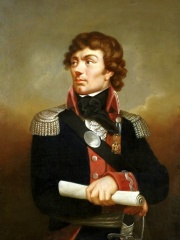
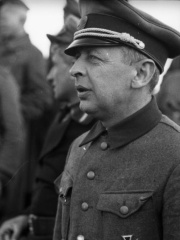
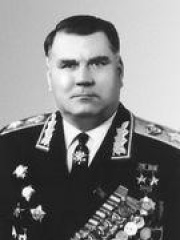
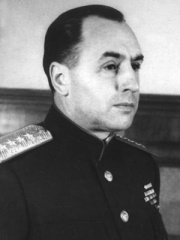
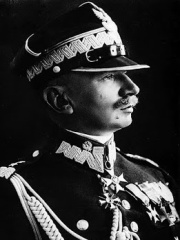
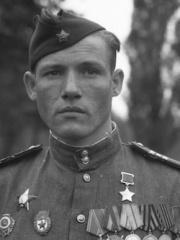
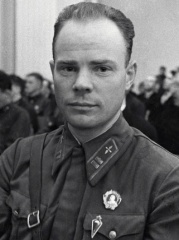
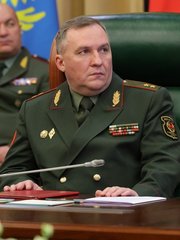
The Most Famous
MILITARY PERSONNELS from Belarus
This page contains a list of the greatest Belarusian Military Personnels. The pantheon dataset contains 2,058 Military Personnels, 9 of which were born in Belarus. This makes Belarus the birth place of the 30th most number of Military Personnels behind Azerbaijan, and Sweden.
Top 9
The following people are considered by Pantheon to be the most legendary Belarusian Military Personnels of all time. This list of famous Belarusian Military Personnels is sorted by HPI (Historical Popularity Index), a metric that aggregates information on a biography's online popularity.

1. Tadeusz Kościuszko (1746 - 1817)
With an HPI of 76.24, Tadeusz Kościuszko is the most famous Belarusian Military Personnel. His biography has been translated into 59 different languages on wikipedia.
Andrzej Tadeusz Bonawentura Kościuszko (English: Andrew Thaddeus Bonaventure Kosciuszko; 4 or 12 February 1746 – 15 October 1817) was a Polish military engineer, statesman, and military leader who became a national hero in Poland, the United States, Lithuania, and Belarus. He fought in the Polish–Lithuanian Commonwealth's struggles against Russia and Prussia, and on the U.S. side in the American Revolutionary War. As Supreme Commander of the Polish National Armed Forces, he led the 1794 Kościuszko Uprising. Kościuszko was born in February 1746, in a manor house on the Mereczowszczyzna estate in Brest Litovsk Voivodeship, then Grand Duchy of Lithuania, a part of the Polish–Lithuanian Commonwealth, now the Ivatsevichy District of Belarus. At age 20, he graduated from the Corps of Cadets in Warsaw, Poland. After the start of the War of the Bar Confederation in 1768, Kościuszko moved to France in 1769 to study. He returned to the Commonwealth in 1774, two years after the First Partition, and was a tutor in Józef Sylwester Sosnowski's household. In 1776, Kościuszko moved to North America, where he took part in the American Revolutionary War as a colonel in the Continental Army. An accomplished military architect, he designed and oversaw the construction of state-of-the-art fortifications, including those at West Point, New York. In 1783, in recognition of his services, the Continental Congress promoted him to brigadier general. Upon returning to Poland in 1784, Kościuszko was commissioned as a major general in the Polish–Lithuanian Commonwealth Army in 1789. After the Polish–Russian War of 1792 resulted in the Commonwealth's Second Partition, he commanded an uprising against the Russian Empire in March 1794 until he was captured at the Battle of Maciejowice in October 1794. The defeat of the Kościuszko Uprising that November led to Poland's Third Partition in 1795, which ended the Commonwealth. In 1796, following the death of Tsaritsa Catherine II, Kościuszko was pardoned by her successor, Tsar Paul I, and he emigrated to the United States. A close friend of Thomas Jefferson, with whom he shared ideals of human rights, Kościuszko wrote a will in 1798, dedicating his U.S. assets to the education and freedom of the U.S. slaves. Kościuszko eventually returned to Europe and lived in Switzerland until his death in 1817. The execution of his testament later proved difficult, and the funds were never used for the purpose he intended.

2. Bronislav Kaminski (1899 - 1944)
With an HPI of 67.00, Bronislav Kaminski is the 2nd most famous Belarusian Military Personnel. His biography has been translated into 23 different languages.
Bronislav Vladislavovich Kaminski (Russian: Бронисла́в Владисла́вович Ками́нский; 16 June 1899 – 28 August 1944) was a Soviet Nazi collaborator. Some publications mistakenly give Kaminski's first name as Mieczyslaw. Kaminski was the commander of the eponymous Kaminski Brigade, an anti-partisan and rear-security formation made up of people from the so-called Lokot Autonomy territory (1941–1943) in part of the German-occupied area of the Soviet Union. The Kaminski Brigade later became part of the Waffen-SS as the Waffen-Sturmbrigade RONA (Russkaya Osvoboditelnaya Narodnaya Armiya — Russian People's Liberation Army). Under Kaminski's command, the unit committed numerous war crimes and atrocities in the German-occupied Soviet Union and in Poland. The unit is regarded as one of the most brutal units, with Kaminski himself feared by his subordinates. Kaminski's behavior made the Germans lose confidence in him: in August 1944, he was court-martialed and executed. His brigade was later disbanded and its remaining personnel absorbed into General Andrey Vlasov's Russian Liberation Army.

3. Ivan Yakubovsky (1912 - 1976)
With an HPI of 65.94, Ivan Yakubovsky is the 3rd most famous Belarusian Military Personnel. His biography has been translated into 32 different languages.
Ivan Ignatyevich Yakubovsky (Belarusian: Іван Ігнатавіч Якубоўскі, romanized: Ivan Ihnatavič Jakuboŭski, Russian: Ива́н Игна́тьевич Якубо́вский; 7 January 1912 – 30 November 1976) was a military officer in the Soviet Army during the Cold War. He was a Marshal of the Soviet Union, twice made a Hero of the Soviet Union, and served as commander-in-chief of the Warsaw Pact from 1967 to 1976.

4. Aleksei Antonov (1896 - 1962)
With an HPI of 65.57, Aleksei Antonov is the 4th most famous Belarusian Military Personnel. His biography has been translated into 36 different languages.
Aleksei Innokentievich Antonov (Russian: Алексей Иннокентьевич Антонов; 9 September 1896 – 16 June 1962) was a General of the Soviet Army, awarded the Order of Victory for his efforts in World War II. From 1945 to 1946 he was Chief of the General Staff of the Armed Forces of the Soviet Union.
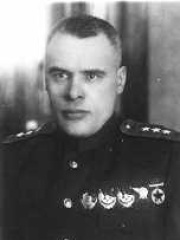
5. Fyodor Kuznetsov (1898 - 1961)
With an HPI of 63.49, Fyodor Kuznetsov is the 5th most famous Belarusian Military Personnel. His biography has been translated into 24 different languages.
Fyodor Isidorovich Kuznetsov (Russian: Фёдор Иси́дорович Кузнецо́в; 29 September 1898 – 22 March 1961) was a Colonel General and military commander in the Soviet Union.

6. Juliusz Rómmel (1881 - 1967)
With an HPI of 62.29, Juliusz Rómmel is the 6th most famous Belarusian Military Personnel. His biography has been translated into 18 different languages.
Juliusz Karol Wilhelm Józef Rómmel (German: Julius Karl Wilhelm Josef Freiherr von Rummel; 3 June 1881 – 8 September 1967) was a Polish military commander, a general of the Polish Armed Forces. He graduated from the Corps of Cadets in Pskov and later from Кonstantin Artillery School at St. Petersburg. During World War I he served as a Russian Imperial army officer and fought in the 1st Guards Artillery Brigade. In 1917 he joined the Polish Army. During the Polish–Soviet War, he gained great fame for achieving a decisive victory in the Battle of Komarów, the largest cavalry engagement of the 20th century. A commander of two Polish armies during the invasion of Poland of 1939, Rómmel was one of the most controversial of the generals to serve during that conflict. After the invasion he was captured by German troops and interned in a POW camp in Murnau. After liberation by the Americans he returned to Poland to serve as Commander in Chief. After 1956 Rómmel worked in the Association of Fighters for Freedom and Democracy.

7. Mikhail Yegorov (1923 - 1975)
With an HPI of 58.02, Mikhail Yegorov is the 7th most famous Belarusian Military Personnel. His biography has been translated into 24 different languages.
Mikhail Alekseyevich Yegorov (Russian: Михаил Алексеевич Егоров; 5 May 1923 – 20 June 1975) was a sergeant of the Soviet Army who, along with Meliton Kantaria and Alexei Berest, was one of the three soldiers credited with having hoisted the Victory Banner over the Reichstag on 1 May 1945 after the Battle of Berlin. Yegorov joined the partisans during the Nazi occupation, then enlisted in the Red Army in late 1944 as an infantry scout. He worked at a dairy farm after leaving the army. In 1975, he was killed in a traffic accident at the age of 52.

8. Sergey Gritsevets (1909 - 1939)
With an HPI of 54.02, Sergey Gritsevets is the 8th most famous Belarusian Military Personnel. His biography has been translated into 18 different languages.
Sergey Ivanovich Gritsevets (Belarusian: Сяргей Іванавіч Грыцавец, Russian: Сергей Иванович Грицевец; 19 July [O.S. 6 July] 1909 – 16 September 1939) was a Soviet major and pilot who was twice awarded the title Hero of the Soviet Union.

9. Viktor Khrenin (b. 1971)
With an HPI of 45.70, Viktor Khrenin is the 9th most famous Belarusian Military Personnel. His biography has been translated into 15 different languages.
Viktor Gennadievich Khrenin (born 1 August 1971) is a Belarusian senior military officer and the current minister of defense since 2020.
People
Pantheon has 9 people classified as Belarusian military personnels born between 1746 and 1971. Of these 9, 1 (11.11%) of them are still alive today. The most famous living Belarusian military personnels include Viktor Khrenin. The most famous deceased Belarusian military personnels include Tadeusz Kościuszko, Bronislav Kaminski, and Ivan Yakubovsky. As of April 2024, 1 new Belarusian military personnels have been added to Pantheon including Viktor Khrenin.
Living Belarusian Military Personnels
Go to all RankingsDeceased Belarusian Military Personnels
Go to all RankingsTadeusz Kościuszko
1746 - 1817
HPI: 76.24
Bronislav Kaminski
1899 - 1944
HPI: 67.00
Ivan Yakubovsky
1912 - 1976
HPI: 65.94
Aleksei Antonov
1896 - 1962
HPI: 65.57
Fyodor Kuznetsov
1898 - 1961
HPI: 63.49
Juliusz Rómmel
1881 - 1967
HPI: 62.29
Mikhail Yegorov
1923 - 1975
HPI: 58.02
Sergey Gritsevets
1909 - 1939
HPI: 54.02
Newly Added Belarusian Military Personnels (2025)
Go to all RankingsOverlapping Lives
Which Military Personnels were alive at the same time? This visualization shows the lifespans of the 8 most globally memorable Military Personnels since 1700.

